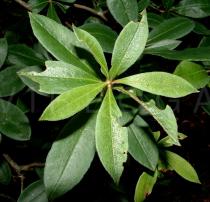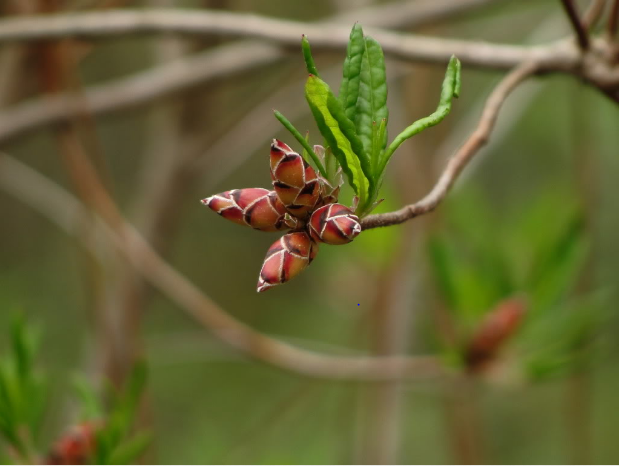| General Description | A native flowering deciduous shrub with dark green foliage and nice autumn colour. |
| ID Characteristic | Rhododendron viscosum is the last species to flower in the azalea group. A much-branched woody shrub with long tubular flowers it gives off a clove-like aroma and the flowers are attractive to butterflies. The branches are smooth with sticky glandular hairs. The leaves are lustrous dark green with red and turn red or purple in autumn. |
| Shape | It is a loose and open. |
| Landscape | Rhododendron viscosum is a popular, native woody landscape plant and can be planted in a variety of situations, where with its ease of culture it will most always thrive. |
| Propagation | Plant seeds with in a 2:1 perlite/peat mixture and germinate at 7 - 10°C in moist, acidic soil. It may also be propagated by root cuttings. |
| Cultivation | It prefers moist soil conditions but will tolerate soils that may suffer from temporary flooding. A pH range from 4.0 - 6.0 is desirable but it will not tolerate salt or pollution. R. viscosum will tolerate slight soil compaction as long as the pH and soil moisture requirements are met. It prefers full sun to partial shade. |
| Pests | Rain in spring can result in fungal diseases, however using systemic fungicides ahead of time can prevent this from developing, although mildew may not be a concern in less humid climates Aphids and cochineal scale may be of occasional concern. |
| Habitat | In swamps, bogs, and alongside streams, in acidic moist peat/muck soils. |
| Bark/Stem Description | Bark is sand-brown or greyish and smooth. |
| Flower/Leaf Bud Description | Greenish or yellow-brown bud scales with evident brown margins. Flower buds are usually 3 cm long and possess 8 - 12 bud scales. |
| Leaf Description | Leaves are simple, alternate and glossy green, occasionally bluish green. Smooth beneath, with stiff white hairs on the midrib. Leaves are clustered at the end of branches measuring 3.5 - 9 cm in length and are 1 - 3 cm wide, they are narrowly ovate or oblong-oblanceolate. |
| Flower Description | Flowers are white to pink with a spicy, clove-like smell, blooming in early summer. They are 3.5 – 5 cm long, and have sundew-like excretions from the stipulate glands of the inflorescence. |
| Fruit Description | The fruit is 1 - 2 cm long, dry, brown, densely hairy capsule. |
| Colour Description | In spring, the foliage colour is light green turning to dark green in summer. Autumn brings yellowish, orange to maroon purple foliage. When it blooms, the flowers are white to pink, the flower bud is also pink. The capsule fruit is dark brown. with dark brown fruit. It is one of the few Azalea's with an excellent bronze colour in the autumn. |
| Texture Description | The plant overall has a coarse to medium texture, in leaf it has a softer character. |



